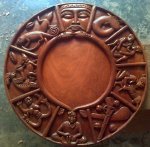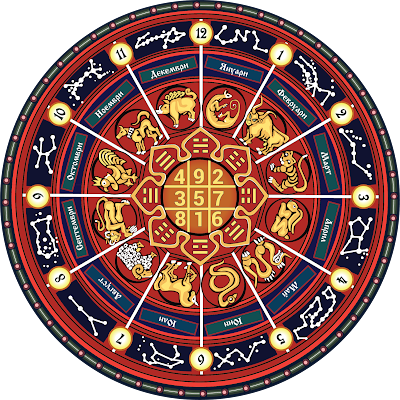Clarity,
Office 17622,
PO Box 6945,
London.
W1A 6US
United Kingdom
Phone/ Voicemail:
+44 (0)20 3287 3053 (UK)
+1 (561) 459-4758 (US).


Hi Qiaozi:... I am also wondering if there are Chinese divination trays in existence, or still being made, with the trigrams instead of Orishas.



Hi Gmulii:Yea. Also seems familiar to the proto-bulgarian calendars ...
But the Trigrams are more challenging to see. Yet its strange how similar the characters for the numbers are set. May be worth checking, maybe both will be tibetan or both wil be proto-Bulgarian...
BNR Radio Bulgaria History and Religion
June 17, 2008, 8:13 PM BG, 5:13 PM GMT
The ancient calendar of the Bulgarians
It is well established that very few kingdoms in antiquity had their own original astronomical calendars. That is why even some of the most civilized ancient peoples like the Jews, the Greeks, the Romans and the Armenians used the calendars of other, older civilizations: the Assyrians, the Babylonians, the Egyptians and the Persians.
And this makes the fact that the ancient Bulgarians had a calendar of their own all the more significant. Today, one of the unique creations of humankind, the ancient Bulgarian calendar is considered by UNESCO to be the most accurate calendar known to man.
The ancient Bulgarian calendar was circular in shape, and inside the circle, there were 12 constellations, named after animals «a rooster, a dog, a boar, a mouse, a snow lion, a rabbit, a dragon, a snake, a horse, a sheep and a monkey».
The calendar was used to follow the movement of the sun but most of all of Jupiter, which was especially revered by Bulgarians. They called Jupiter «Yankul» the master of time and it was depicted as a circle with three flames.
Besides the names of these constellations, the calendar also makes mention of the ancient Bulgarian numerals. This is an extremely old system of counting and a very accurate way of rounding off numbers, which shows that ancient Bulgarians had
a certain level of mathematical knowledge, supplementing their knowledge of astronomy.
What makes the ancient Bulgarian calendar unique is that it was based on the Sun and Jupiter, making it extremely accurate.
The year consisted of 364 «counted» days and one «uncounted» or 365 days in all. The «uncounted» day was the day of the winter solstice, according to the Gregorian calendar it fell on December 22 and was called by the Bulgarians «zero» day, or Eni, Sur, Young year, Surva year, Ignazhden (the latter-day St. Ignatius’ day).
These popular names all meant «the only, separate day, on which the new year begins», and it was precisely December 22, the shortest day of the year, that the ancient Bulgarians considered to be the start of the new year, so it was not included in
any month.
Actually, the calendar includes one more «uncounted» day. It was called Behti, and was inserted once every 4 years in-between June 30 and July 1, after Midsummer day, the day of the summer solstice, known as Enyovden or Eni Setem.
The ordinary Bulgarian calendar year had 364 counted days and one uncounted days, 365 in all. The leap year had 364 counted and 2 uncounted days, or 366 days. The counted days were distributed into 52 weeks of seven days each. Sunday was the first day of the week, Wednesday its middle, and Saturday its end.
The year was divided into 4 quarters, each of them 91 days long or 13 weeks. The first of the three months always had 31 days, and the second and third 30 days.
Prof Yordan Vulev says the number of counted days, 364, in the ancient Bulgarian calendar is a «golden number», as it can be divided by 4 the number of the seasons), by 13 the number of weeks in each season) and by 52, the number of weeks in a year.
Source: Wayback Machine, here:
Clarity,
Office 17622,
PO Box 6945,
London.
W1A 6US
United Kingdom
Phone/ Voicemail:
+44 (0)20 3287 3053 (UK)
+1 (561) 459-4758 (US).